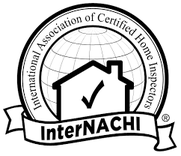Four Point Inspection
A Four Point Inspection may be required before an insurance policy is issued on older homes. It focuses only on the four most common elements of a home that may have worn out over decades of service or that may need to be updated or replaced because their failure could lead to significant damage to your home. The inspection is completed by a qualified GGTI Home Inspector. They will inspect these four components:
1. Heating & Air Conditioning
The inspector will look at the size of the air/heating conditioning unit, the date it was installed and check to be sure it is in good working order.
2. Electrical Wiring & Panels
The National Electrical Code is a standard often adopted by municipalities and states, and it gets updated every three years to reset minimum electrical standards for both technical improvements and fire safety. Our inspector will check for frayed, loose or exposed wiring, for adequate grounding and to make sure the electrical breakers are the proper size. Old or exposed wiring and panels may require updating or replacement before insurance can be offered.
3. Plumbing Connections & Fixtures
Inspection entails looking at the age and condition of the plumbing system – from the water heater to the main supply line and waste lines and vents. The review will mean looking for leaks, properly functioning shutoff valves and the type of piping used.
4. Roof
For the roof, an inspector will look at the age and condition, plus note the type of construction and geometry. Roof shape matters in the price of homeowner insurance, particularly in coastal areas. A hip roof is pyramid shaped and slopes down on all sides, making it less vulnerable to high winds. The type of roof covering, sheathing and the way the roof is anchored to the rafters will also be noted.
The cost of an inspection depends on the size of the home, its age and location. A small home or condo can usually be inspected in about an hour or less, while an older, large home may take longer to properly inspect. In either case, the Four Point Inspection form itself is short, usually no more than two pages. The licensed professional inspector who checks your property will make comments on the form that will simply state if repairs are needed or not.
A Four Point Inspection may be required before an insurance policy is issued on older homes. It focuses only on the four most common elements of a home that may have worn out over decades of service or that may need to be updated or replaced because their failure could lead to significant damage to your home. The inspection is completed by a qualified GGTI Home Inspector. They will inspect these four components:
1. Heating & Air Conditioning
The inspector will look at the size of the air/heating conditioning unit, the date it was installed and check to be sure it is in good working order.
2. Electrical Wiring & Panels
The National Electrical Code is a standard often adopted by municipalities and states, and it gets updated every three years to reset minimum electrical standards for both technical improvements and fire safety. Our inspector will check for frayed, loose or exposed wiring, for adequate grounding and to make sure the electrical breakers are the proper size. Old or exposed wiring and panels may require updating or replacement before insurance can be offered.
3. Plumbing Connections & Fixtures
Inspection entails looking at the age and condition of the plumbing system – from the water heater to the main supply line and waste lines and vents. The review will mean looking for leaks, properly functioning shutoff valves and the type of piping used.
4. Roof
For the roof, an inspector will look at the age and condition, plus note the type of construction and geometry. Roof shape matters in the price of homeowner insurance, particularly in coastal areas. A hip roof is pyramid shaped and slopes down on all sides, making it less vulnerable to high winds. The type of roof covering, sheathing and the way the roof is anchored to the rafters will also be noted.
The cost of an inspection depends on the size of the home, its age and location. A small home or condo can usually be inspected in about an hour or less, while an older, large home may take longer to properly inspect. In either case, the Four Point Inspection form itself is short, usually no more than two pages. The licensed professional inspector who checks your property will make comments on the form that will simply state if repairs are needed or not.
